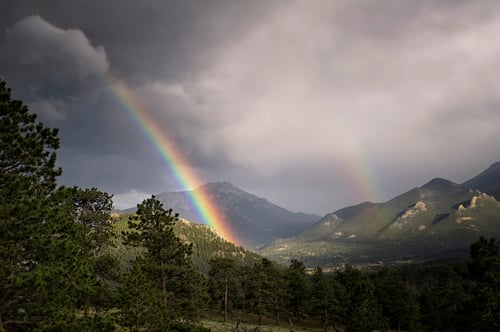Kermit The Frog once posed the question, “Why are there so many songs about rainbows, and what’s on the other side?” The arrival of monsoon season in the Four Corners states brings daily afternoon storms—and with those storms comes the opportunity to see rainbows! Kermit had the right idea when he called rainbows illusions. Towards the end of a storm, when the sun begins to peak back through the clouds, the sun’s light begins to dance with the lingering rain. As light enters a raindrop, it bounces around (reflects) and gets scattered into a beautiful array of color that is then projected onto the horizon. This projection is unique to every observer, meaning no two people have ever seen the exact same rainbow.

Rainbow after a thunderstorm in Colorado Mountains.
When we think about rainbows, most people imagine an arc, sometimes stemming from white fluffy clouds and sometimes leading to pots of gold. In some mythologies, rainbows were thought to be bridges that connected the worlds of the living to the dead. To those searching for gold, I have bad news: every rainbow we see is actually a complete circle. Since we tend to see rainbows from the ground, the horizon line blocks the rest of the rainbow from view. The next time you fly in a plane, keep an eye out your window for that endless circular rainbow.
Earlier in the morning or later in the afternoon when the sun sits closer to the horizon, we might be lucky enough to experience two rainbows seemingly stacked one on top of the other. A double rainbow occurs when the dance between sunlight and rain extends, and light stays inside a raindrop for a couple more turns. The projection then contains a primary rainbow, thin with vibrant colors, and a secondary rainbow that appears wider and more pastel with inverted colors. This secondary rainbow mirrors the first, a product of the second reflection within the raindrop being projected onto the sky.
Storms are not the only times we can experience the awe of a rainbow. These elusive wonders can appear in fog, in the spray of a waterfall, through crystal prisms, and—under the right conditions—from the light of the moon (we call this a moonbow). You can even create a rainbow in your backyard! With your back to the sun, spray a garden hose on the mist setting (being mindful of the amount of water you are using), and you will be able to see small rainbows begin to play in the water coming out of the hose.
Since rainbows are a trick of the light, there are no sides (sorry Kermit), and we cannot touch them or follow them in search of hidden riches. Based on the portrayal of rainbows in mythology and folklore, we know our ancestors felt some kind of magic when rainbows appeared on the horizon, and even though we can explain how and why rainbows occur, I think we can all agree with Kermit The Frog in saying “we know that it’s probably magic”.
Kate Miller is a Summer Naturalist at Walking Mountains Science Center. She loves dancing in the rain and will try to take a picture of every rainbow she sees.







